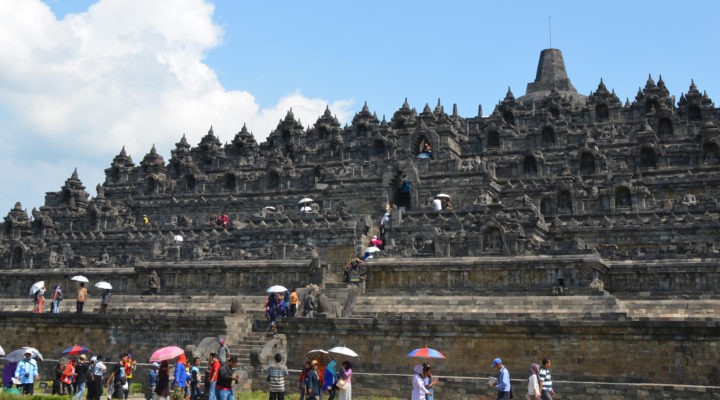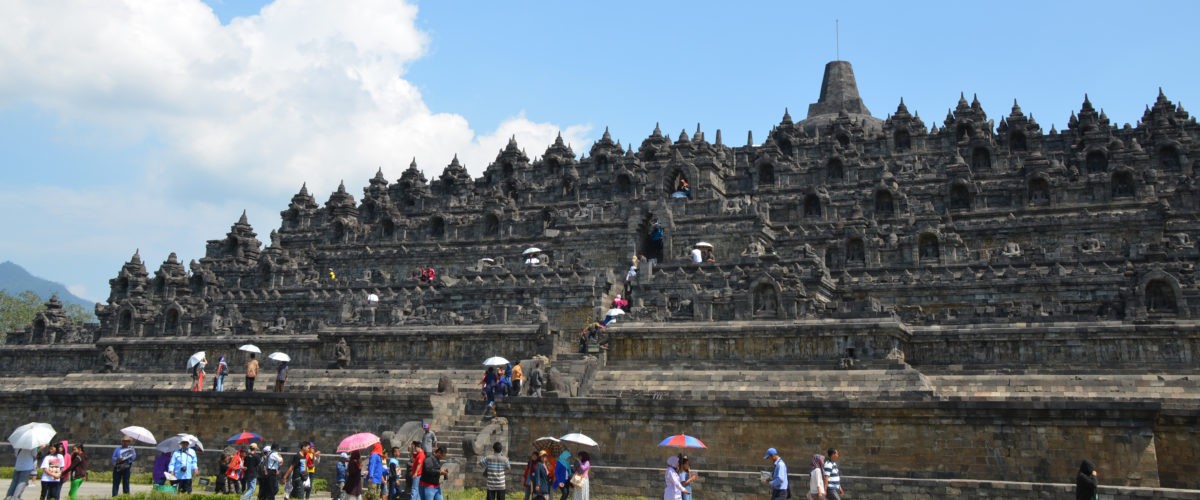Interfaith friendship is my passion. How did a lifelong Christian — born and reared in the family of a Southern Baptist pastor, who holds three degrees from a Baptist university and seminary, and is an ordained Baptist minister and 25-year missionary in Asia — arrive at this destination?
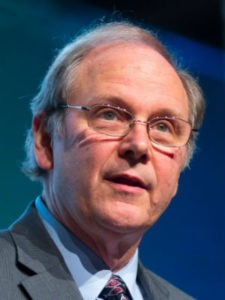 In 1973, as a 28-year-old, I became a published lyricist when a missions musical I co-authored with Bill O’Brien, called The Namegivers, was published by Broadman Press. One of the songs, “On a Journey,” tells part of my story: I’m on a journey to become. Seizing what cannot be planned, a chance for letting self expand. Stretching tall to reach the key that will unlock authentic me. Squinting in the gathering haze for visions equal to these days. Striding at an eager pace convinced I soon will know my place.
In 1973, as a 28-year-old, I became a published lyricist when a missions musical I co-authored with Bill O’Brien, called The Namegivers, was published by Broadman Press. One of the songs, “On a Journey,” tells part of my story: I’m on a journey to become. Seizing what cannot be planned, a chance for letting self expand. Stretching tall to reach the key that will unlock authentic me. Squinting in the gathering haze for visions equal to these days. Striding at an eager pace convinced I soon will know my place.
Having penned those words as a young minister still very much in formation, I did not realize how unconventional choices, determined effort, visionary thought and confident explorations would aid my own becoming. Now, decades later, I still am a work in progress. Even in my 75th year of life, I trust that I am growing and changing. Here are some important mileposts on my journey.
Pensacola and Tampa, Florida
My early years were spent in Pensacola, Fla., where religious diversity primarily consisted of Protestants, Catholics and Jews. During elementary school, I spent hundreds of hours with Marty and Diane, my Italian Catholic friends who lived next door. Neither the ceramic statue of the Virgin Mary on the mantle nor the crosses on chains around their necks struck me as very different from the ways we expressed love for Jesus in my family.
We moved to Tampa when I was in seventh grade, and I soon met a Jewish classmate named Tom. Later that year, he invited me to attend his bar mitzvah ceremony — my first time to witness a sacred ritual from a religion other than my own. Hearing Tom chant the prayer in Hebrew before the reading of Torah seemed both strangely alien and perfectly familiar when considered in the context of my own youth group activities at church.
“My dad and mom encouraged my early journey toward interfaith awareness and acceptance.”
My dad and mom encouraged my early journey toward interfaith awareness and acceptance. They celebrated my friendship with our Catholic neighbors when many Protestants in the 1950s looked with suspicion at the Catholic Church. They were pleased with my friendship with my Jewish classmate and were especially bold for supporting my desire to attend his bar mitzvah since many Baptist church members of that era did not understand why their pastor’s son would go to a synagogue service.
Clinton, Mississippi
Attending a university in Mississippi from 1963-1967 introduced me to racial inequalities in America. One evening during my freshman year, four friends and I drove across the countryside to Tougaloo College, described at the time as a “historic, private college for Negros.”
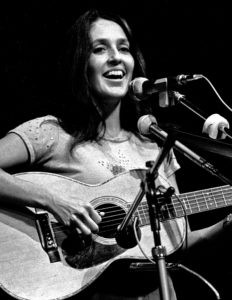
Joan Baez (Creative Commons)
We were the only five whites in the packed auditorium of excited fans of the famous folk singer Joan Baez. At the end of her concert, when she asked everyone to stand and join in the Pete Seeger song that had become the Civil Rights anthem, we linked arms with those on either side of us, swaying and singing with great emotion: “We’ll walk hand in hand. We shall live in peace. We shall all be free. We are not afraid. We shall overcome.”
Returning to our privileged, all-white campus after midnight, we were too unsophisticated to realize it was our commitment to justice that had connected us to the Tougaloo students, and certainly not any common identity as Christians or Baptists.
My senior year of college brought another life-altering experience. For six years I had spent every summer working on the staff of a boys’ camp in North Carolina. But one day in the early fall of 1966, I walked into the office of the Baptist Student Union director, who smiled and said: “Sellers, you don’t need to go back to camp for the seventh year in a row. Why don’t you apply for the student summer missions program after graduation? There’s a position in the Philippines that’s a great fit for you!”
“Missions?” I protested. “I’m not interested in missions!” But because I respected my mentor, I decided to apply to the selection committee and was fortunate to be chosen to spend 11 weeks in that country 9,000 miles from my Florida home. What I didn’t realize then, but know with certainty now after more than 50 years of involvement in missions, is that his seemingly random comment changed the direction of my entire journey.
Manila, Philippines
A few days after my arrival in Manila, I was taken to see those whom some might label “disposable people.”
“They live here on what the locals call Smokey Mountain,” my missionary host said, gesturing from our air-conditioned car toward the hovels constructed of bamboo poles, duct-taped cardboard, torn sheets of plywood, bent corrugated tin, plastic string and whatever else of any use had been rescued from someone’s trash. “This is the dumping place for all of Manila’s garbage, collected from more than 6 million homes,” he explained.
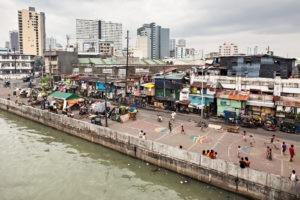
Slum region in Manila, Philippines, with urban center in background. (bigstockphoto)
The hot, muggy breeze carried the rancid smell of decay, and acres of smoldering refuse extended as far as I could see.
“Having nowhere else to go,” the missionary continued, “these people live on the trash heaps, existing on whatever they can scavenge. From the time their children can walk, they play in that garbage, search through it for ‘treasures’ and may even eat discarded food they discover.”
Speechless, I shook my head in disbelief. It was so far removed from where we had stopped, earlier, for an American hamburger at the poolside restaurant of the Manila Intercontinental Hotel. I gulped for air — but it wasn’t just the smoke and stench that made my eyes water: it was the undeniable tug of compassion and a gnawing guilt over the disparity, the unfairness, the obscenity of how far the world of these people was from my world.
The moment also surfaced for me a tragic disconnect: I had been sent by Mississippi Baptist students to share good news, a Christian message of hope and joy. But this startling spectacle had taught me that any genuinely “good” news must address the physical and not just the spiritual needs of these people. I also realized that the compassion I felt for these strangers on Smokey Mountain had nothing to do with our being fellow believers, because they were obviously different from me culturally, and probably religiously, as well.
Central Java, Indonesia
After profound experiences in the Philippines, I dreamed of one day returning to Asia as a cross-cultural missionary. But it was almost 10 years before my wife, Janie, and I would make our home in Indonesia. There, we lived surrounded by natural beauty — volcanic mountains, terraced rice fields, coral beaches and rain forests — and by gracious, interesting people whom we came to appreciate and love. Over the years, Indonesia’s national motto, “Bhinekka Tunggal Ika” (Unity in Diversity) — became my personal, philosophical watchword.
When I arrived as a young, idealistic missionary, I knew very little about the folk religions, Hinduism, Buddhism, Confucianism and Islam that most Indonesians practice. Nothing I had learned from my formal education or ministry experience had prepared me adequately for living in a multi-layered, pluralistic setting like Java.
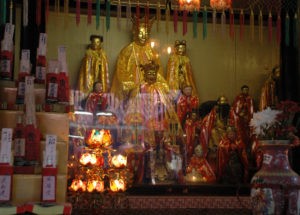
Temple in Indonesia
Every neighborhood, for example, had its own mosque, where faithful Muslims went each Friday to pray, give alms and submit themselves to God. On I’dul Adha, the Day of Sacrifice commemorating the story in the Koran of Abraham’s willingness to sacrifice his son Ishmael, I once joined 200,000 Muslims at South Jakarta’s major mosque to observe the slaughter of hundreds of donated goats and oxen and the distribution of the meat to the eagerly awaiting poor.
Less than a kilometer from the Baptist seminary where Janie and I taught classes — and well within range of the amplified call to prayer sounding from the nearest minaret — was Gedung Batu. This ancient shrine was built to honor the Ming Dynasty sea captain Cheng Ho, who dropped anchor in the local harbor in 1406 and was identified by welcoming townspeople as the deity Sam Po Kung. Thousands visited this grotto to burn incense before one of the brightly painted images. It was peaceful to sit in the courtyard beneath orange-blossomed trees to observe the earnestness of my Chinese neighbors.
Overlooking that temple complex and dotting the hillsides near our city were dozens of villages populated by families who farmed just as their ancestors had done for thousands of years. Many planted and harvested following time-tested rituals to please Dewi Sri, the rice goddess, hoping thereby to guarantee a plentiful crop.
With university friends, I once traveled to the southern coast of the island and joined hundreds of villagers solemnly walking to the beach. There, they placed orchid offerings on the outgoing tide to placate the powerful underwater deity, Loro Kidul, hoping to secure safety for their loved ones who daily went out in pontoon boats to fish the unpredictable waters of the South Java Sea.
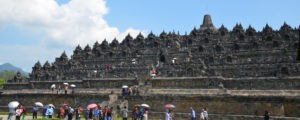
Borobudur, the largest Buddhist temple in the world.
Not far from these communities of traditional animists are two architectural wonders: Borobudur, the largest Buddhist temple in the world, and its magnificent Hindu counterpart, Prambanan, each built during the Hindu-Buddhist kingdoms that flourished in Central Java more than 1,300 years ago.
Late one humid evening, on the birthday of the Buddha, Janie and I sat cross-legged on the grass with thousands of the faithful as saffron-robed monks led a torchlit processional that circumambulated the ascending path of Borobudur, commemorating the Middle Way that leads to nirvana and the extinguishing of the flame of ignorance and desire. On another occasion, under a full moon, we sat entranced by the exotic sounds of gamelan instruments as a hundred costumed dancers enacted Hindu Ramayana tales on the hand-carved stone platforms of Prambanan.
Fellow humans I met on the journey
As I reflect on my journey toward interfaith friendship, I cannot overlook particular experiences that validated my common humanity with those who follow different religious paths.
One such experience happened at Pangandaran Beach in West Java, where we took our young son and daughter over the New Year’s weekend of 1982. The seashore was relatively empty when we unfolded our towels, got out the children’s plastic toys and applied sunscreen. But within a few minutes, word had spread that we were there — londos (“whites”) — on the beach with beautiful, blond children. After a few minutes, more than a hundred Javanese adults stood in a polite circle, 10 or 15 feet from and surrounding our oblivious toddlers.
With wide, betel nut-stained smiles and sparkling eyes, these onlookers confirmed not that they saw us as unwelcome foreigners, but as guests whom, though curious, they also valued. It was easy to perceive, in that ever-growing crowd, the tenderness with which typical Javanese grownups treat children.
“They were not like us. Except that they were just like us.”
These were not likely Christians, for West Java residents are from the Sundanese tribe, statistically 98% Muslim. So, they were not like us. Except that they were just like us, for as part of the human family they also were touched by the innocence and wonder of childhood.
Another incident took place in our neighborhood in South Jakarta. Our young children already were asleep in their beds one evening when we began to hear loud explosions near our home. Walking into the street, I encountered hundreds of people hurrying away from danger, some carrying meager belongings. Then we heard on television that a fire had started at a nearby military police armory. Rocket shells, stacked like cordwood, had ignited and were flying off in all directions into the night sky. We lived very close to the armory, so the shells were still climbing as they went over our neighborhood, but they were coming down all over Jakarta, crashing through the roofs of houses and injuring or killing many unsuspecting people.
I later considered that most of those fleeing persons were not Christians. They were people we had never met — neighbors frightened for the safety of themselves, their children and elderly relatives. The accident created panic. It was scary, and those were our brothers and sisters in pain.
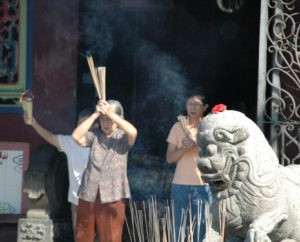 For a quarter century, we lived in Asia among people who in their humanity were just like us, yet who in their pursuit of the sacred were intriguingly different. My experiences prodded me to pursue a path of discovery as I began intentionally to study the world’s cultures, peoples and religions and to consider how I could be a Christian in a pluralistic world.
For a quarter century, we lived in Asia among people who in their humanity were just like us, yet who in their pursuit of the sacred were intriguingly different. My experiences prodded me to pursue a path of discovery as I began intentionally to study the world’s cultures, peoples and religions and to consider how I could be a Christian in a pluralistic world.
Gradually, two impressions of these followers of other spiritual paths became clear. One realization was how truly alike we all were. We had the very same dreams, fears, hopes, worries, defeats and victories that mark all human life.
The second thought was how very different we were. Their sacred stories and rituals were radically “other” than the ones I cherished, yet I recognized that many of these people gained enormous strength from their own religions. And I also admitted that the devotion, self-discipline and genuine goodness of these people challenged (and sometimes shamed) my spiritual maturity and moral character.
Abilene and Chicago
So, when we lost our Indonesian visas and returned to the United States in 1996, I brought my passion for cultural and religious diversity back with me and became increasingly involved in the interfaith movement. Locally, I served as an officer in the Abilene Interfaith Council, while teaching all of my Logsdon Seminary classes from the perspective of cultural appreciation and interreligious understanding.
Nationally, I have served as a member of the Interfaith and Collaboration Table of the National Council of Churches and helped to plan and lead three National Baptist-Muslim Dialogues.
Internationally, I was a member for 10 years of the Interfaith Relations Commission of the Baptist World Alliance and, more recently, was a trustee and, later, chair of the Parliament of the World’s Religions in Chicago.
Lessons learned
This pilgrimage of discovery takes a long time — maybe as long as a lifetime — and even then we likely will not have uncovered all of the Mystery. Recognizing this reality, author and philosopher Sam Keen suggests: “Doubt and dialogue will always be with us. It is not necessary for us to find definitive answers to the unanswerable questions: Why are we here? Where do we come from? Where are we going? And how should we act in the meantime? But we do need to face into the wind and keep the great questions alive.”

Pontoon boats in Indonesia
Facing into the wind requires strength and resolve. Douglas Wood, children’s author of the celebrated Old Turtle books and a naturalist often referred to as a “Renaissance man,” describes the way Jack pines of the North Woods exhibit this power: “This valiant old tree, solitary on its own rocky point, is as beautiful as a living thing can be … . In the calligraphy of its shape against the sky is written strength of character and perseverance, survival of wind, drought, cold, heat, disease … an integrity that comes from being what you are.”
The integrity that comes from being what we are. This phrase resonates strongly with me, because of the sermon my father preached when I was ordained to Christian ministry. “The Word is Integrity” was the title of his challenge, and I have not forgotten that this faithful man who so greatly influenced my life offered this one word of admonition to his son as I prepared to launch out on my career as a young minister.
The journey to become, what I’ve recounted, is my own unique passage to a place of interfaith friendship. But we all have our own paths to travel. In the same way that Pensacola, Tampa, Jackson, Manila, Central Java, Pangandaran Beach, Jakarta, Abilene and Chicago are places that have given meaning to my life, you have experienced places that have connected with your narrative — where hard lessons, important transitions, life-changing words, and divine revelations have shaped you.
We are all human becomings, and it is exciting to realize that no matter our age, we are still sowing seeds in the fields of infinite possibility, seeds that one day hopefully will blossom into the full nature of our authentic selves, as we face into the wind, learn more of the Mystery, and ultimately cross the finish line on our journey to become.
Rob Sellers is professor of theology and missions emeritus at Hardin-Simmons University’s Logsdon Seminary in Abilene, Texas. He is the immediate past chair of the board of the Parliament of the World’s Religions in Chicago. He and his wife, Janie, served a quarter century as missionary teachers in Indonesia.

